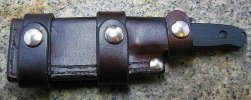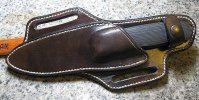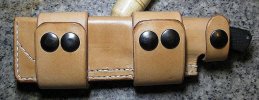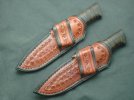- Joined
- Aug 31, 2011
- Messages
- 3,063
I have made about eight knives so far.
I am fairly new at making sheathes, but I enjoy doing it. I like the 8-9 oz leather to make pouch sheathes for bigger knives. I like the stiffness of it, which naturally results in good retention. However, I am currently making very small knives, like OAL of 5 1/2" - 6". I want to make sandwich sheathes for horizontal belt carry. Does it make sense to use a thinner leather for this? I got some 7-8 [correction 6-7] oz leather from Midwest Knife Supply.
Thanks,
--Andy/squid
I am fairly new at making sheathes, but I enjoy doing it. I like the 8-9 oz leather to make pouch sheathes for bigger knives. I like the stiffness of it, which naturally results in good retention. However, I am currently making very small knives, like OAL of 5 1/2" - 6". I want to make sandwich sheathes for horizontal belt carry. Does it make sense to use a thinner leather for this? I got some 7-8 [correction 6-7] oz leather from Midwest Knife Supply.
Thanks,
--Andy/squid
Last edited:






